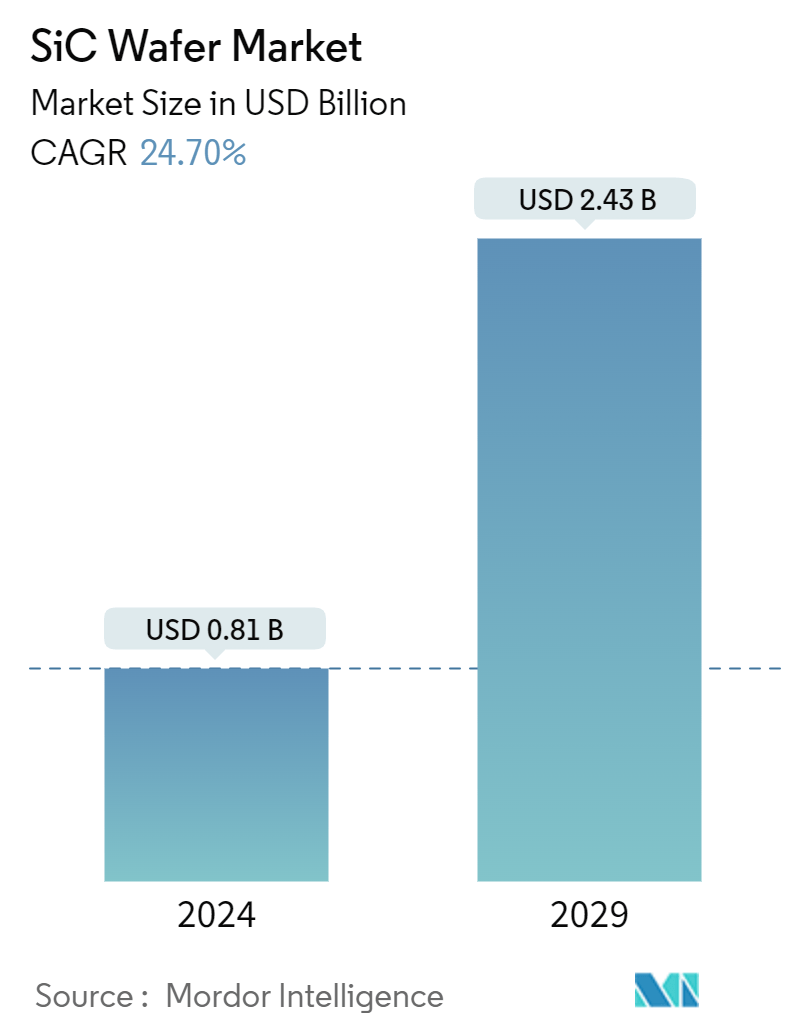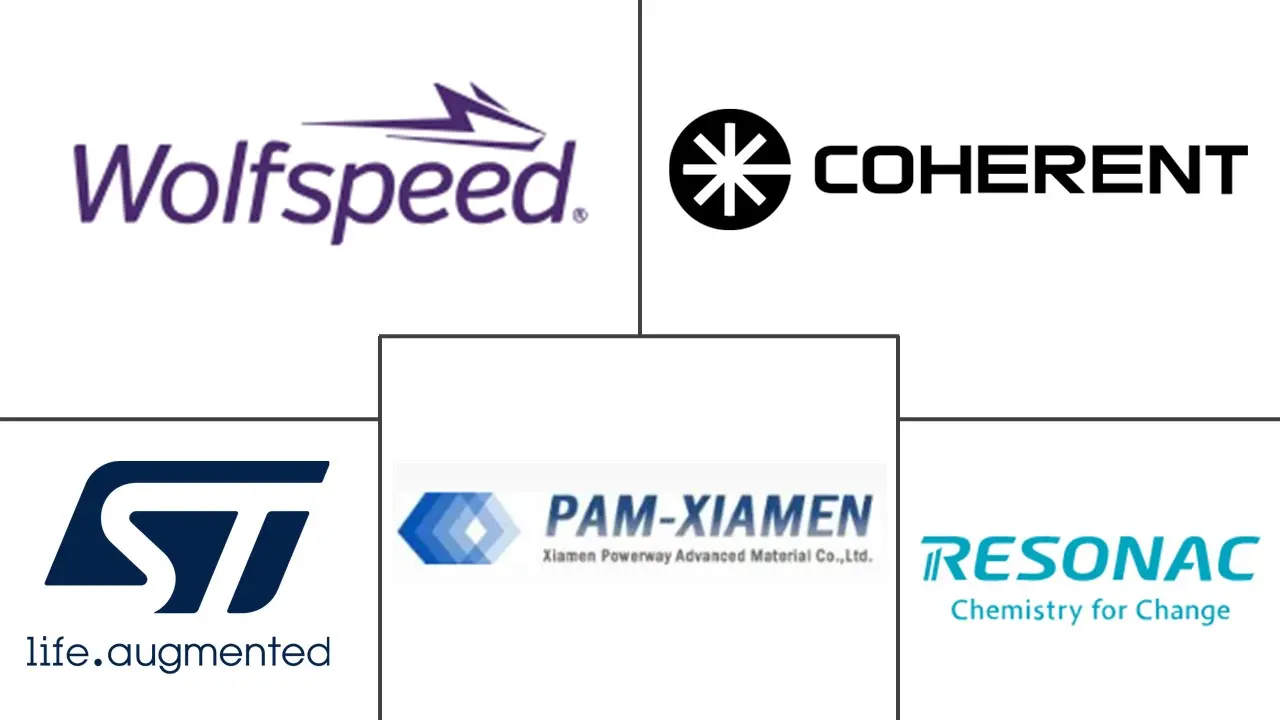Market Size of SiC Wafer Industry

| Study Period | 2019 - 2029 |
| Market Size (2024) | USD 0.81 Billion |
| Market Size (2029) | USD 2.43 Billion |
| CAGR (2024 - 2029) | 24.70 % |
| Fastest Growing Market | Asia Pacific |
| Largest Market | Asia Pacific |
| Market Concentration | Low |
Major Players
*Disclaimer: Major Players sorted in no particular order |
SiC Wafer Market Analysis
The SiC Wafer Market size is estimated at USD 0.81 billion in 2024, and is expected to reach USD 2.43 billion by 2029, growing at a CAGR of 24.70% during the forecast period (2024-2029).
SiC wafers are specialized semiconductor materials known for their exceptional properties. Composed of silicon and carbon, these wafers offer significant advantages over traditional silicon wafers, making them invaluable for a range of high-performance applications.
- A recent report from Aalborg University in Denmark forecasts that annual revenues from power semiconductor devices will more than double by 2030. This growth is expected, as these advanced electronic components are crucial in addressing significant challenges on the path to an energy-efficient society, particularly decarbonization and digitization. Similar to the essential role of semiconductor integrated circuits (ICs) in computers, data storage, and communication, power semiconductors are integral to modern power electronics. Their applications include renewable power generation and transmission, electromobility, automated factories, energy-efficient data centers, smart cities, smart homes, and more.
- WBG semiconductors have received increasing attention as promising materials for high-voltage, low-loss, and fast-switching power devices. Among the WBG semiconductors, SiC, GaN, Ga2O3, aluminum nitride (AIN), and diamond are considered to be potential materials for the next generations of power semiconductors. In recent years, significant advancements in material quality, innovative device designs, and improved process capabilities have driven the progress of SiCs, resulting in a broad range of technology demonstrators and commercial products now available in the market.
- The global auto industry is undergoing a sea change, with implications for the energy sector, as electrification is set to avoid the need for 5 million barrels of oil a day by 2030. Market trends and policy efforts in major car markets support a bright outlook for EV sales. Under the IEA Stated Policies Scenario (STEPS), the global outlook for the share of electric car sales based on existing policies and firm objectives has increased to 35% in 2030, up from less than 25% in the previous outlook.
- In the production flow, specialized SiC wafers and substrates are developed and processed in a fab, resulting in SiC-based power semiconductors. Many SiC-based power semiconductors are used in power electronics, where the devices convert and control the electricity in systems.
- A larger wafer size offers more dies per unit area. The extra space to fabricate more dies enables semiconductor fabrication plants and OSATs (outsourced semiconductor assembly and test) to manufacture, test, or assemble more dies in a specific time. This increases the rate at which new products can be fabricated or assembled. To some extent, increasing wafer size also impacts the supply chain positively.
SiC Wafer Market Segmentation
SiC is a silicon-carbon semiconductor compound that belongs to the wide-bandgap class of materials. The semiconductor's strong physical bond provides excellent mechanical, chemical, and thermal stability. The wafering process involves converting a solid SiC puck into an epi- or device-ready prime wafer.
The SiC wafer market is segmented by wafer size (2-, 3-, and 4-inch, 6-inch, and 8- and 12-inch), by application (power, radio frequency (RF) and other applications), by end-user industry (telecom and communications, automotive and electric vehicles (EVs), photovoltaic/power supply/energy storage, industrial [UPS and motor drives], other end-user industries), and by geography (North America, Europe, Asia-Pacific, and Rest of the World). The market sizes and forecasts for value (USD) for all the segments mentioned above have been provided.
| By Wafer Size | |
| 2-, 3-, and 4-inch | |
| 6-inch | |
| 8- and 12-inch |
| By Application | |
| Power | |
| Radio Frequency (RF) | |
| Other Applications |
| By End-user Industry | |
| Telecom and Communications | |
| Automotive and Electric Vehicles (EVs) | |
| Photovoltaic/Power Supply/Energy Storage | |
| Industrial (UPS and Motor Drives, etc.) | |
| Other End-user Industries |
| By Geography*** | |
| North America | |
| Europe | |
| Asia | |
| Australia and New Zealand | |
| Latin America | |
| Middle East and Africa |
SiC Wafer Market Size Summary
The SiC wafer market is poised for significant growth, driven by the superior properties of silicon carbide semiconductors, which outperform traditional silicon and gallium arsenide devices in high-power and high-frequency applications. SiC technology offers benefits such as reduced switching losses, enhanced power density, and superior heat dissipation, making it ideal for power electronics used in various sectors, including automotive, renewable energy, and telecommunications. The automotive industry, in particular, is leveraging SiC-based power modules to improve the efficiency and performance of electric vehicles. Additionally, the increasing deployment of 5G technology is boosting the demand for SiC wafers, as they are essential for manufacturing RF power amplifiers that operate efficiently in high-frequency bands.
The Asia-Pacific region is a dominant player in the SiC wafer market, supported by robust government policies and a strong semiconductor industry presence in countries like Taiwan, China, and South Korea. The region's growth is further fueled by the expanding renewable energy sector, with countries like India making significant strides in solar energy capacity. The market is characterized by intense competition, with key players such as Resonac Holdings Corporation, STMicroelectronics, and Wolfspeed Inc. actively pursuing strategic collaborations to enhance their market share. Recent investments and agreements, such as those between Coherent Corp. and Denso Corporation, and Renesas Electronics Corporation and Wolfspeed Inc., highlight the ongoing efforts to secure supply commitments and expand production capabilities, ensuring the market's continued expansion.
SiC Wafer Market Size - Table of Contents
-
1. MARKET INSIGHTS
-
1.1 Market Overview
-
1.2 Industry Attractiveness - Porter's Five Forces Analysis
-
1.2.1 Bargaining Power of Suppliers
-
1.2.2 Bargaining Power of Buyers
-
1.2.3 Threat of New Entrants
-
1.2.4 Threat of Substitute Products
-
1.2.5 Intensity of Competitive Rivalry
-
-
1.3 Technology Insights
-
1.4 Impact of COVID-19 Aftereffects and Other Macroeconomic Factors on the Market
-
-
2. MARKET SEGMENTATION
-
2.1 By Wafer Size
-
2.1.1 2-, 3-, and 4-inch
-
2.1.2 6-inch
-
2.1.3 8- and 12-inch
-
-
2.2 By Application
-
2.2.1 Power
-
2.2.2 Radio Frequency (RF)
-
2.2.3 Other Applications
-
-
2.3 By End-user Industry
-
2.3.1 Telecom and Communications
-
2.3.2 Automotive and Electric Vehicles (EVs)
-
2.3.3 Photovoltaic/Power Supply/Energy Storage
-
2.3.4 Industrial (UPS and Motor Drives, etc.)
-
2.3.5 Other End-user Industries
-
-
2.4 By Geography***
-
2.4.1 North America
-
2.4.2 Europe
-
2.4.3 Asia
-
2.4.4 Australia and New Zealand
-
2.4.5 Latin America
-
2.4.6 Middle East and Africa
-
-
SiC Wafer Market Size FAQs
How big is the SiC Wafer Market?
The SiC Wafer Market size is expected to reach USD 0.81 billion in 2024 and grow at a CAGR of 24.70% to reach USD 2.43 billion by 2029.
What is the current SiC Wafer Market size?
In 2024, the SiC Wafer Market size is expected to reach USD 0.81 billion.

